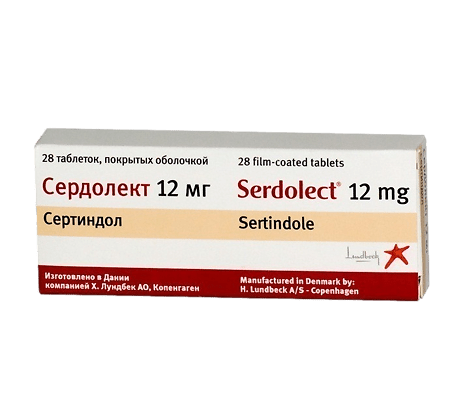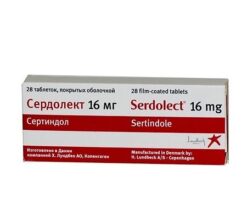No products in the cart.
Serdollect, 12 mg 28 pcs
€1.00
Out of stock
(E-mail when Stock is available)
Description
Cardoleptic is an atypical neuroleptic, phenylindole derivative, selectively acting on limbic structures. It has antipsychotic effect.
Pharmacodynamics
The neuropharmacological profile of sertindol as an antipsychotic is due to selective blockade of mesolimbic dopaminergic neurons and a balanced inhibitory effect on central dopamine D2 receptors and serotonin 5-HT2 receptors as well as α1 -adrenergic receptors.
Antipsychotics increase serum prolactin levels due to blockade of dopamine receptors. In patients taking Seardolect on short-term therapy and during long-term treatment (1 year), prolactin levels remained within normal limits.
Certindol has no effect on muscarinic and histamine H1 receptors, which is confirmed by the absence of anticholinergic and sedative effects that are associated with effects on these receptors.
Pharmacokinetics
Sertindol is well absorbed from the gut, with maximum concentration reached approximately 10 hours after ingestion. Food intake has no effect on the rate and magnitude of absorption.
The apparent volume of distribution of sertindol after repeated administration is about 20 l/kg. Sertindol is 99.5% bound to plasma proteins. Sertindol penetrates through the blood-brain barrier and the placental barrier.
Sertindol is metabolized in the liver with the participation of cytochromes P450 2D6 and P450 3A.
The metabolites have no neuroleptic activity.
The elimination half-life is about 3 days.
Sertindol and its metabolites are excreted mainly in the feces and partially in the urine.
Indications
Indications
Treatment of schizophrenia.
Sertindol is not recommended for emergency treatment of acute psychotic disorders.
Active ingredient
Active ingredient
Composition
Composition
1 film-coated tablet contains:
active ingredient:
sertindol 12 mg.
excipients – corn starch,
lactose monohydrate,
microcrystalline cellulose,
Hyprolose,
Magnesium stearate,
Sodium croscarmellose.
coating:
Hypromellose,
Titanium dioxide (E171),
macragol 400 and 4 mg – iron oxide yellow (E172),
12 mg – iron oxide yellow (E172),
iron oxide red (E172),
16 mg – iron oxide red (E172),
20 mg – iron oxide yellow (E172),
iron oxide red (E172),
iron oxide black (E172).
How to take, the dosage
How to take, the dosage
Cardolec is prescribed orally once a day, regardless of meals.
All patients should start treatment with 4 mg per day. The daily dose should be increased by 4 mg every 4 to 5 days to reach the optimal dose in the range of 12 to 20 mg/day. The maximum dose is 24 mg/day.
The maximum dose is prescribed in exceptional cases because of the risk of prolongation of the QT interval with increasing doses.
Elderly patients:
Prescribing Ceardolect should be preceded by a thorough cardiovascular evaluation. Slower dose escalation is required and lower doses should be used.
Decreased renal function: Ceardolect may be used in usual dosages in patients with renal insufficiency. Hemodialysis does not affect the pharmacokinetics of the drug.
Decreased liver function: Slower dose escalation and lower doses should be used in patients with mild to moderate hepatic impairment.
Reappointment of Cardolect after a break in treatment: If less than a week has elapsed since stopping Cardolect, gradual dose escalation is not necessary (the previous dosage may be prescribed). In other cases, the dosage should be increased to the optimal dosage gradually by titration, and an ECG study should be performed before titration.
Transition from another neuroleptic: Treatment with Ceardolect may begin with the recommended gradual dose escalation at the same time as discontinuation of another oral neuroleptic. For patients on depot neuroleptic treatment, Cerdolect is prescribed instead of the next depot injection.
Interaction
Interaction
The risk of QT interval prolongation increases with concomitant treatment with drugs that prolong the QT interval or inhibit the metabolism of sertindole. The use of Ceardolect concomitantly with these drugs is prohibited.
Certindole is metabolized by the cytochromes P450 2D6 and P450 3A.
Plasma concentrations of sertindol are increased when concomitantly administered with drugs that inhibit cytochrome P450 2D6 (fluoxetine, paroxetine, quinidine, etc.). It may be necessary to prescribe a lower maintenance dose, and an ECG examination before and after changing the dose of these drugs.
In turn, sertindol and its major metabolites have a weak inhibitory effect on the activity of cytochrome P450 2D6, through which β-adrenoblockers, antiarrhythmic agents, some hypotensive agents, a large number of antipsychotic drugs and antidepressants are metabolized.
The simultaneous use of sertindol and macrolide antibiotics (erythromycin) and calcium channel blockers (diltiazem, verapamil) may lead to a slight increase (&450 2D6. Since it is quite difficult to establish these patients routinely, simultaneous use of sertindol and drugs that inhibit cytochrome P450 3A is contraindicated, as this may lead to a significant increase in the plasma concentration of sertindol.
The metabolism of sertindol can be significantly increased, leading to a decrease in its plasma concentrations, under the influence of the following drugs – rifampicin, carbamazepine, phenytoin, phenobarbital. Decreased antipsychotic activity of sertindol in such cases may require increasing its dose.
Special Instructions
Special Instructions
Because of the precautions associated with QT interval prolongation and ECG monitoring, sertindol should be prescribed in cases where at least one other antipsychotic is already intolerant.
The risk of QT interval prolongation is greater with higher doses (20-24 mg/day). Lengthening of the QT interval while taking a number of drugs may lead to the development of paroxysms of ventricular tachycardia and sudden death.
Hypertension monitoring is necessary during dose titration and at the beginning of maintenance therapy.
Cardiovascular system
An ECG study should be performed before prescribing Cardolect. If the QT interval is greater than 450 msec in men and 470 msec in women, Ceardolect should not be prescribed.
The ECG study should be performed before prescribing the drug, when equilibrium concentration is reached approximately 3 weeks after initiation or daily dose of 16 mg, and 3 months after initiation of treatment. During maintenance therapy, an ECG study should be performed every 3 months.
During maintenance treatment, ECG studies should be performed before and after increasing the dose of sertindol or after joining/increasing the dose of a drug that may increase the blood concentration of sertindol.
If the QT interval is prolonged beyond 500 msec, sertindol should be stopped.
If a patient presents with symptoms such as palpitations, seizures, fainting, indicating a possible arrhythmia, the treating physician should immediately begin an examination of the patient, including an ECG.
The ECG study should preferably be done in the morning.
Electrolyte disturbances
In patients at risk of developing significant electrolyte disturbances, serum potassium and magnesium levels should be measured before starting treatment with Ceardolectom. Hypokalemia and hypomagnesemia should be corrected before starting sertindol. Monitoring of plasma potassium concentrations is recommended in patients with vomiting and diarrhea, in patients taking potassium-eluting diuretics, and in other electrolyte disorders.
Parkinson’s disease
The antipsychotics may inhibit the effects of dopamine agonists. Cardolect should be used with caution in patients with Parkinson’s disease.
Decreased liver function
In mild to moderate cases of impaired liver function, close monitoring of the patient’s condition is necessary. A slower dose escalation and a smaller maintenance dose is recommended.
Convulsive seizures
Cardolept should be prescribed with caution in patients with a history of seizures.
Late dyskinesia
Long-term use of antipsychotic drugs, especially in high doses, is associated with the risk of developing late dyskinesia. If symptoms of tardive dyskinesia occur while taking sertindol, the dosage should be reduced or the drug should be stopped altogether.
Malignant neuroleptic syndrome (MNS)
In cases of MNS, immediate withdrawal of the drug is necessary.
Withdrawal syndrome
In abrupt withdrawal of antipsychotics, nausea, vomiting, increased sweating, and insomnia may occur. There may also be a return of psychotic symptoms and the appearance of involuntary motor disorders (akathisia, dystonia, dyskinesia). Gradual withdrawal of the drug is necessary.
Excipients
The tablets contain lactose monohydrate. The drug should not be prescribed to patients with hereditary galactose intolerance, lactase deficiency or impaired glucose and galactose absorption.
Pregnancy and lactation
Because the safety of Ceardolect in humans has not been studied in pregnancy, this drug should not be prescribed to pregnant women.
The safety of using Ceardolect in breastfeeding women has not been studied. In cases where the use of Sertindol has been found to be necessary, breastfeeding should be discontinued.
Children and adolescents (under 18 years)
The safety and effectiveness of Ceardolect has not been studied in children and adolescents, so the drug should not be used in children and adolescents.
Impact on ability to drive or operate machinery
Although Ceardolect has no sedative effect, patients are not recommended to drive or operate other machinery while taking it until individual tolerance of the drug is established.
Contraindications
Contraindications
Side effects
Side effects
The following side effects have been observed (in decreasing order of frequency of occurrence): Rhinitis and nasal breathing difficulties, decreased ejaculate volume, dizziness, dry mouth, postural hypotension, weight gain, peripheral edema, dyspnea, paresthesias, prolonged QT interval, leukocyturia and hematuria, hyperglycemia, syncope, seizure disorders, movement disorders including tardive dyskinesia, paroxysms of ventricular tachycardia (such as & “torsade de pointes&”).
Extrapyramidal symptoms on sertindol administration occur with the same frequency as with placebo.
Malignant neuroleptic syndrome is very rare.
Some side effects, such as postural hypotension, are transient and occur at the beginning of therapy.
Overdose
Overdose
Symptoms. Drowsiness, slurred speech, tachycardia, decreased BP, and transient prolongation of the QT interval. Paroxysms of ventricular tachycardia (such as & “torsade de pointes&”) may occur, especially when sertindol is used in combination with drugs that can cause this type of side effect.
Treatment. In cases of overdose, the drug should be discontinued immediately, and measures should be taken to maintain airway patency and adequate oxygenation. Monitoring of ECG and basic somatic parameters should be started immediately. In cases of QT interval prolongation, ECG monitoring is performed until normalization of this parameter, and the half-life of sertindol (2 to 4 days) should be taken into account.
The intravenous catheter should be placed, gastric lavage, activated charcoal and laxatives should be prescribed.
There is no specific antidote and the drug cannot be eliminated by dialysis. Therefore, supportive therapy should be prescribed.
Correction of BP decrease and vascular collapse manifestations is carried out using intravenous administration of solutions. If sympathomimetics are used, adrenaline or dopamine should be used with caution because stimulation of β-adrenoreceptors together with the inherent antagonistic effect on α1-adrenoreceptors may result in a marked decrease in BP.
If antiarrhythmics are used, it should be considered that drugs such as quinidine, disopyramide, procainamide can potentially prolong the QT interval. If severe extrapyramidal disorders develop, anticholinergic drugs should be prescribed. The patient should be under constant medical supervision until full recovery.
Pregnancy use
Pregnancy use
The safety of using the drug Ceardolet in pregnancy and lactation has not been studied.
Prescribing in pregnancy is contraindicated.
Breastfeeding should be stopped if it is necessary to use Ceardolect during lactation.
Additional information
| Shelf life | 5 years |
|---|---|
| Conditions of storage | In a light-protected place, at a temperature not exceeding 25 °C |
| Manufacturer | Х. Lundbeck A/O, Denmark |
| Medication form | pills |
| Brand | Х. Lundbeck A/O |
Other forms…
Related products
Buy Serdollect, 12 mg 28 pcs with delivery to USA, UK, Europe and over 120 other countries.














